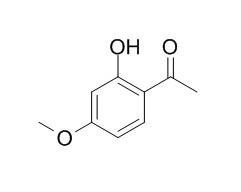Natural Products
Paeonol
| Catalog No. | CFN98926 |  |
| CAS No. | 552-41-0 | |
| Molecular Weight: | 166.2 | |
| Molecular Formula | C9H10O3 | |
| DBs | [PubChem]:274951579 [ChEMBL]:69581 [PCIDB]:2704 |
Standard InChI:
InChI=1S/C9H10O3/c1-6(10)8-4-3-7(12-2)5-9(8)11/h3-5,11H,1-2H3
Biological Activity
Paeonol , the main active compound of the traditionally used Chinese herb Paeonia lactiflora Pallas, has anti-inflammatory, antioxidant and cardiovascular protective activities;Paeonol inhibits U937 monocyte adhesion to HUVECs stimulated by TNF-α, the inhibitory effect of paeonol on ICAM-1 production may be mediated by inhibiting p38, ERK and NF-κB signaling pathways, which are involved in TNF-α-induced ICAM-1 production, thus, paeonol may be beneficial in the treatment of cardiovascular disorders such as atherosclerosis.[1]
Paeonol exerts its anti-inflammatory and analgesic effects in a rat model of carrageenan-evoked thermal hyperalgesia, the mechanism may be associated with decreased production of proinflammatory cytokines, NO and PGE2 and increased production of IL-10, an anti-inflammatory cytokine in carrageenan-injected rat paws, and attenuation of the elevated iNOS and COX-2 protein expression as well as neutrophil infiltration in carrageenan-injected paws may also be involved in the beneficial effects of paeonol.[2]
Paeonol reduces cerebral infarct and neuro-deficit in rat, suggests it might play a similar role in reducing cerebral infarction in humans, it suppresses and scavenges superoxide anion, and inhibits microglia activation and IL-1beta in ischemia-reperfusion injured rats.
Paeonol can attenuates neurotoxicity and ameliorates cognitive impairment induced by d -galactose in ICR mice, suggests that paeonol possesses anti-aging efficacy and may have potential in treatment of neurodegenerative diseases.[3]
Paeonol has antiproliferation and apoptosis induction in HepG_2 cells, also has significantly growth-inhibitory and apoptosis-inducing effects in gastric cancer cells both in
vitro and in vivo.[4,5]
Product
References
[1] Nizamutdinova I T, Oh H M, Min Y N, et al. Int Immunopharmacol, 2007, 7(3):343-50.
[2] Chou T C. Brit J Pharmacol, 2003, 139(6):1146-52.
[3] Hsieh C L, Cheng C Y, Tsai T H, et al. J Ethnopharmacol, 2006, 106(2):208-15.
[4] Zhong S Z, Ge Q H, Qu R, et al. J Neurol Sci, 2009, 277(1-2):58-64.
[5] Xu S P, Sun G P, Shen Y X, et al. World J Gastroentero, 2007, 13(2):250-6.
[6] Li N, Fan L L, Sun G P, et al. World J Gastroentero, 2010, 16(35):4483-90.
Product Use Citation





